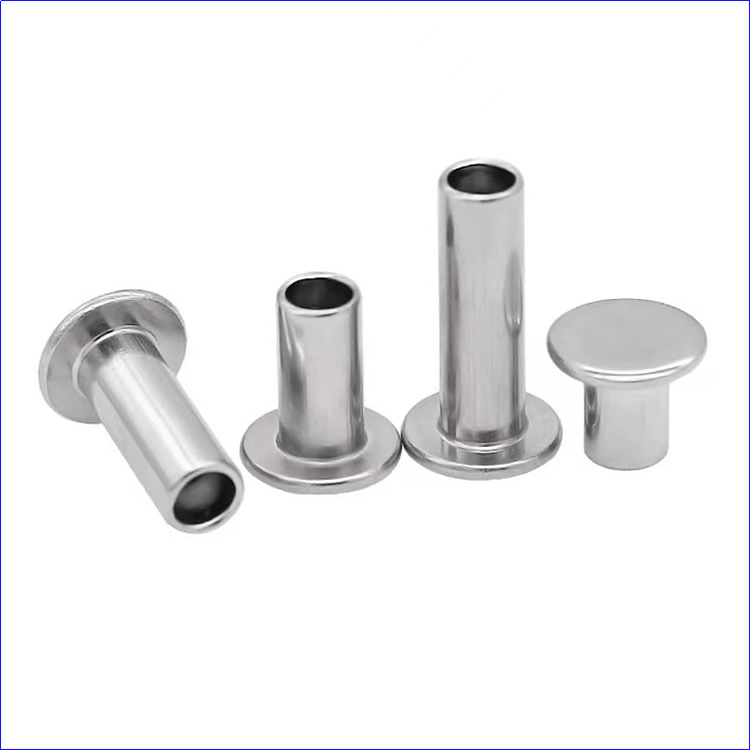Something About Semi-Hollow Rivets
2025-11-03
Semi-hollow rivets are mechanical connectors with a hollow tail. They work by squeezing the hollow portion and flanging it outward to create a permanent snap-on fixation. Their core applications are concentrated in light industries such as apparel, footwear, and luggage. Their use of soft wire material avoids cracking during rivet assembly and offers cost advantages.
Semi-tubular rivets are typically made of stainless steel (such as SUS304) or aluminum alloy, with diameters ranging from 0.8 to 35 mm and tensile strengths reaching 550 to 900 MPa. Semi-hollow rivets are widely used as shaft replacements in apparel, footwear, luggage, and toys. Their structural characteristics also lend themselves to applications in automotive manufacturing, such as riveting aluminum bodywork. Manufacturers generally provide standardized processing procedures and non-standard customization services to ensure that the products have surface quality without sand holes, pits, or cracks.

Structural principle
The main body of the semi-hollow rivet is divided into a solid rod and a hollow tail. During installation, a special tool is used to apply axial pressure to the tail, causing the thin-walled hollow structure to undergo plastic deformation and fold outward, forming a snap-on structure with a diameter larger than the hole diameter. This non-detachable mechanical locking method can avoid the risk of wire breakage in the fixation of clothing accessories, and is more suitable for riveting soft materials than traditional cuff nails.
Application Areas
Apparel and footwear: Mainly used for permanent fixation of metal buttons, shoe eyes, and decorative fasteners, and through the hollow flange structure, non-destructive riveting of soft substrates such as leather and textile fabrics is achieved. Industry data in 2025 showed that applications in this field accounted for 42% of the total output [1].
Luggage manufacturing: At the connection between the metal corner and the handle of password boxes and suitcases, semi hollow rivets can withstand repeated opening and closing impact loads, and have completely replaced threaded fasteners in the military luggage field.
Automotive Industry: FFR semi tubular rivets feature a semi-hollow design, with the hollow tail section forming a flanged buckle through extrusion. They are used by car brands such as Mercedes-Benz, Audi, BMW, Jaguar Land Rover, and BYD as key components for body connections.
Stroller Manufacturing: Products with diameters of 3.5-5mm are used at the attachment points of stroller frames, leveraging their seismic performance to enhance the stability of the frame structure.
Material Parameters
Mainstream products utilize SUS304 stainless steel. Its chromium-nickel alloy composition makes the rivets resistant to oxidation and corrosion, with a salt spray test life exceeding 500 hours. Tensile strength varies depending on the heat treatment process, ranging from 550 MPA (standard) to 900 MPA (high-strength). Diameters are available in a stepped distribution: micro rivets of 1.2-2.5mm are commonly used in the apparel industry, while medium-to-large rivets of 4-8mm are used in automotive manufacturing.
Production Process
Manufacturers utilize multi-station cold heading technology, completing the 12-step process of blanking, roughening, and punching. Key quality control points include: Hollow wall thickness uniformity deviation ≤ 0.02mm Flanging angle controlled within 90°-120° range [1] Surface roughness Ra ≤ 0.8μm Full-process quality inspection covers dimensional go/no-go gauge testing, metallographic structure analysis and destructive tensile testing to ensure that the product meets the requirements of GB/T 869-1986 standard.
Usage precautions
During riveting operations, the nail body length should be selected according to the thickness of the base material. Usually, the hollow section length is reserved for 1.2-1.5 times the total thickness. Hydraulic tools with a pressure of ≤ 3 tons should be used for leather products to avoid excessive extrusion that may cause the base material to tear. Special rivet guns are required for installation in the automotive industry to ensure that the flanging angle is accurately controlled within the range of 105°±2°.
Do you want to know more about semi tubular rivets? Feel free to contact us.



